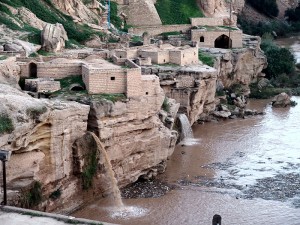Our Heritage activists (Iran / Branch) are reporting that the Shushtar historical hydraulic systems are in danger of major deterioration and destruction. The site which was inscribed in 2009 as a “historical hydraulic masterpiece of creative genius” by UNESCO is an Iranian national heritage site and can be traced back to Darius the Great in the 5th century B.C. It involved the creation of two main diversion canals on the river Kârun one of which, Gargar canal, is still in use providing water to the city of Shushtar via a series of tunnels that supply water to mills. It forms a spectacular cliff from which water cascades into a downstream basin. It then enters the plain situated south of the city where it has enabled the planting of orchards and farming over a vast area known as Mianâb (Paradise). The property has an ensemble of remarkable sites including the Salâsel Castel, the operation centre of the entire hydraulic system, the tower where the water level is measured, damns, bridges, basins and mills.
It is believed by international experts; engineers and archeologists that the Sassanid engineers had created a structure that was a masterpiece. The river was channeled to form a moat around the city, while bridges and main gates into Shushtar were built to the east, west, and south. Several rivers nearby are conducive to the extension of agriculture and the cultivation of sugar cane. A system of subterranean channels called Ghanats, connected the river to the private reservoirs of houses and buildings, and supplied water for domestic use and irrigation, as well as to store and supply water during times of war when the main gates were closed. Traces of these ghanats can still be found in the crypts of some houses. This complex system of irrigation degenerated during the 19th century.
Over the last ten years, neglect of the cultural heritage in Iran has escalated and has impacted many historical and heritage sites and in the case of Shushtar Historical Hydraulic Systems, UNESCO demanded (in April 2011) that Iranian government submit explanations regarding the situation following the collapse of a portion of the Gargar Bridge at the Shushtar’s ancient water system.
















